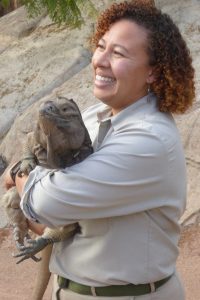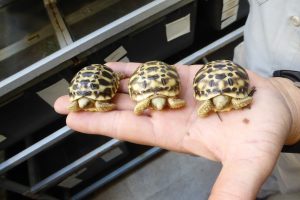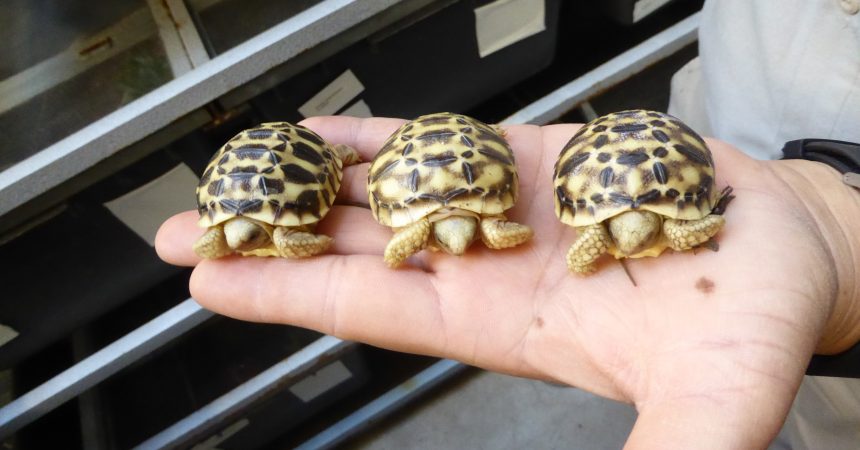Zoo InternQuest is a seven-week career exploration program for San Diego County high school juniors and seniors. Students have the unique opportunity to meet professionals working for the San Diego Zoo, Safari Park, and Institute for Conservation Research, learn about their jobs, and then blog about their experience online. Follow their adventure here on the Zoo’s website!
 Ever since its founding in the year 1916, the San Diego Zoo has been responsible for the care of thousands of animals. But some of its current inhabitants have been around for almost as long as the Zoo itself. I’m talking, of course, about the Galápagos tortoise, one of the longest-living land animal species in the world. There are currently thirteen Galápagos tortoises living at the Zoo. And this past Wednesday, we received the incredible honor of meeting some of them up close, along with several of their reptilian relatives over at the Reptile House.
Ever since its founding in the year 1916, the San Diego Zoo has been responsible for the care of thousands of animals. But some of its current inhabitants have been around for almost as long as the Zoo itself. I’m talking, of course, about the Galápagos tortoise, one of the longest-living land animal species in the world. There are currently thirteen Galápagos tortoises living at the Zoo. And this past Wednesday, we received the incredible honor of meeting some of them up close, along with several of their reptilian relatives over at the Reptile House.
Ms. Rachael Walton, a Senior Reptile Keeper at the Zoo, brought us into the Reptile House to show us the wide variety of reptiles that are, well, housed there. Due to their cold-bloodedness, the interior of the Reptile House is kept at about 82 °F, making it noticeably warmer than the cool air settling in San Diego during this time of year. A breeze blew at our backs as we stepped inside, almost as if the Earth itself was beckoning us to see the wondrous creatures that populate its surface.
Almost immediately after our grand entrance, Ms. Walton introduced us to Martin, the caiman lizard that was her first responsibility at the Zoo. Not all of the Zoo’s reptiles have names, since a name wouldn’t serve much purpose for an animal that can’t hear. Martin is special in this regard; he was brought up at the Zoo under the care of Ms. Walton and several other keepers.
Some of the reptiles we met, however, had less pleasant origins. Two of the Zoo’s king cobras were rescued from an attempt to smuggle them from Asia. The smuggler placed them in containers the size of tennis ball canisters, and they were on the verge of death before they arrived at the Zoo. Judging from their current size, it’s safe to say that they’ve recovered immensely since that incident.
Africa also has its fair share of interesting reptiles, and its biodiversity is represented quite well at the Zoo. Leading us into the main hall, Ms. Walton brought out an African hingeback tortoise that sat contentedly on her outstretched hand. When asked why the species is named this way, she explained that the hingeback can lean forward when it rains to collect water in its shell and lap it up. Unfortunately, the increasing presence of humans along the west coast of Africa has displaced the species, preventing them from getting the sustenance that they require.
 Currently, the Zoo is attempting to breed several tortoise species that are critically endangered. Unfortunately, some species are notoriously difficult to breed, and several attempts have resulted in no babies. However, the keepers at the Reptile House are persistent. That day, we saw the adorable result of their hard work: three baby Burmese star tortoises, at only a week old. Newly hatched as they were, these babies still had visible egg teeth and soft shells.
Currently, the Zoo is attempting to breed several tortoise species that are critically endangered. Unfortunately, some species are notoriously difficult to breed, and several attempts have resulted in no babies. However, the keepers at the Reptile House are persistent. That day, we saw the adorable result of their hard work: three baby Burmese star tortoises, at only a week old. Newly hatched as they were, these babies still had visible egg teeth and soft shells.
Our final presenters, meanwhile, have long since lost their egg teeth. We left the Reptile House to venture into the Galápagos tortoise exhibit, where four sleepy tortoises awaited us. At five hundred pounds, these majestic reptiles have lived for almost a century and are still considered to be in their prime. Males of the species, Ms. Walton informed us, compete with one another by determining who can extend his neck the highest. Around us, they served a rather different purpose: not a minute went by when one of us wasn’t gleefully rubbing one of their long necks. The tortoises seemed pleased to be on the receiving end of this treatment, so they let us carry on.
The number of species that we saw that day paled in comparison to how many exist in the wild. Unfortunately, that difference becomes smaller with each approaching day, as manmade causes like deforestation cause species like the Burmese star tortoise to lose their habitats. We need to be willing to help defend the animals that cannot fend for themselves. After all, the evolution of the tortoise shell didn’t take into account how deadly humans can be.
Sunwoo, Real World Team
Week Five, Fall Session 2017


